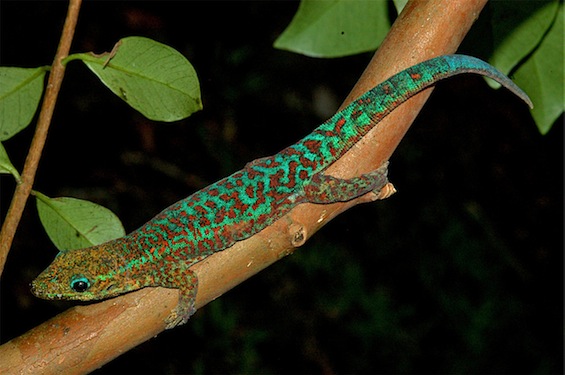
Image © Emmanuel Van Heygen
Distribution
Phelsuma borbonica mater occurs only on the southern coast of Réunion Island from Mare d'Arzule to La Crête. Specific localities are Forest Mare Longue (350 m), Basse-Vallée (500 m), Matouta (200 m) and La Crête (550 m). The subspecies is separated by the volcano Piton de la Fournaise and overlapping is impossible due to this natural barrier.
Terra Typica
Basse-Vallée, Réunion
Biotope
The biotope of Phelsuma borbonica mater is very similar to the one from the nominate form. The gecko lives mainly on larger deciduous trees and on Pandanus at the sun exposed edges or within the primary forests at higher altitudes. Juvenile animals can often be found on the lower young Pandanus trees. Phelsuma borbonica mater can also be found on human made objects like electricity poles, traffic signs, reservoirs, uninhabited huts and houses, picnic huts, etc. These objects are often used as mass egg depositing places by several females, larger objects like huts are permanently inhabited by several males and many females. However, they seem to avoid human populated areas, except in La Crête where the animals sporadically can be found on houses. Réunion Island has basically two seasons the austral winter and summer; in the austral winter temperatures often drop below 10° C during night and early mornings within Phelsuma borbonica borbonica 's range with a relative humidity above 90%. The same locations reach a high temperature during the afternoon of 24° C and in the austral summer up to 28° C. Night time drops are not that drastic during summer but humidity remains high as this is also the rainy season.
Description
Males can reach up to 160 mm not exceeding a snout-vent length of 78mm. Females are smaller (130 mm) with a snout-vent length up to 65 mm. A typical morphological feature of Phelsuma borbonica mater is the blue eye-ring and the brownish head colour. The dorsal colouration is less variable then in the nominate form and is in most cases a mixture of green and blue with irregular red dots that often form two dorsa-lateral stripes. The neck and head regions have a more reticulated pattern. The ventral colour is also very variable and can be from orange in some animals to completely whitish in others with a few red spots.
